SYMLIN
SYMLIN (pramlintide acetate) Injection Rx only
FULL PRESCRIBING INFORMATION: CONTENTS*
- SYMLIN DESCRIPTION
- CLINICAL PHARMACOLOGY
- CLINICAL STUDIES
- SYMLIN INDICATIONS AND USAGE
- SYMLIN CONTRAINDICATIONS
- WARNINGS
- PRECAUTIONS
- SYMLIN ADVERSE REACTIONS
- OVERDOSAGE
- SYMLIN DOSAGE AND ADMINISTRATION
- HOW SUPPLIED
- STORAGE
- Medication Guide
- PRINCIPAL DISPLAY PANEL - 5 mL Vial Label
- PRINCIPAL DISPLAY PANEL - 5 mL Vial Carton
- PRINCIPAL DISPLAY PANEL - 1.5 mL Cartridge Label
- PRINCIPAL DISPLAY PANEL - 1.5 mL Cartridge Carton
- PRINCIPAL DISPLAY PANEL - 2.7 mL Cartridge Label
- PRINCIPAL DISPLAY PANEL - 2.7 mL Cartridge Carton
FULL PRESCRIBING INFORMATION
SYMLIN is used with insulin and has been associated with an increased risk of insulin-induced severe hypoglycemia, particularly in patients with type 1 diabetes. When severe hypoglycemia associated with SYMLIN use occurs, it is seen within 3 hours following a SYMLIN injection. If severe hypoglycemia occurs while operating a motor vehicle, heavy machinery, or while engaging in other high-risk activities, serious injuries may occur. Appropriate patient selection, careful patient instruction, and insulin dose adjustments are critical elements for reducing this risk.
SYMLIN DESCRIPTION
SYMLIN® (pramlintide acetate) injection is an antihyperglycemic drug for use in patients with diabetes treated with insulin. Pramlintide is a synthetic analog of human amylin, a naturally occurring neuroendocrine hormone synthesized by pancreatic beta cells that contributes to glucose control during the postprandial period. Pramlintide is provided as an acetate salt of the synthetic 37-amino acid polypeptide, which differs in amino acid sequence from human amylin by replacement with proline at positions 25 (alanine), 28 (serine), and 29 (serine).
The structural formula of pramlintide acetate is as shown:

Pramlintide acetate is a white powder that has a molecular formula of C171H267N51O53S2• x C2H4O2 (3≤x≤8); the molecular weight is 3949.4. Pramlintide acetate is soluble in water.
SYMLIN is formulated as a clear, isotonic, sterile solution for subcutaneous (SC) administration. The disposable multidose SymlinPen® pen-injector contains 1000 mcg/mL of pramlintide (as acetate); SYMLIN vials contain 600 mcg/mL of pramlintide (as acetate). Both formulations contain 2.25 mg/mL of metacresol as a preservative, D-mannitol as a tonicity modifier, and acetic acid and sodium acetate as pH modifiers. SYMLIN has a pH of approximately 4.0.
CLINICAL PHARMACOLOGY
Amylin Physiology
Amylin is co-located with insulin in secretory granules and co-secreted with insulin by pancreatic beta cells in response to food intake. Amylin and insulin show similar fasting and postprandial patterns in healthy individuals (Figure 1).
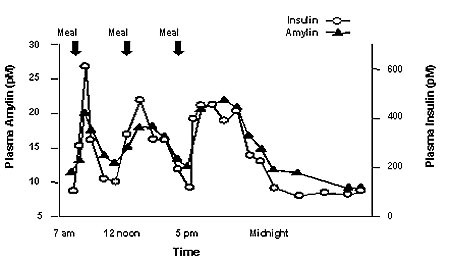
Amylin affects the rate of postprandial glucose appearance through a variety of mechanisms. Amylin slows gastric emptying (i.e., the rate at which food is released from the stomach to the small intestine) without altering the overall absorption of nutrients. In addition, amylin suppresses glucagon secretion (not normalized by insulin alone), which leads to suppression of endogenous glucose output from the liver. Amylin also regulates food intake due to centrally-mediated modulation of appetite.
In patients with insulin-using type 2 or type 1 diabetes, the pancreatic beta cells are dysfunctional or damaged, resulting in reduced secretion of both insulin and amylin in response to food.
Mechanism of Action
SYMLIN, by acting as an amylinomimetic agent, has the following effects: 1) modulation of gastric emptying; 2) prevention of the postprandial rise in plasma glucagon; and 3) satiety leading to decreased caloric intake and potential weight loss.
Gastric Emptying
The gastric-emptying rate is an important determinant of the postprandial rise in plasma glucose. SYMLIN slows the rate at which food is released from the stomach to the small intestine following a meal and, thus, it reduces the initial postprandial increase in plasma glucose. This effect lasts for approximately 3 hours following SYMLIN administration. SYMLIN does not alter the net absorption of ingested carbohydrate or other nutrients.
Postprandial Glucagon Secretion
In patients with diabetes, glucagon concentrations are abnormally elevated during the postprandial period, contributing to hyperglycemia. SYMLIN has been shown to decrease postprandial glucagon concentrations in insulin-using patients with diabetes.
Satiety
SYMLIN administered prior to a meal has been shown to reduce total caloric intake. This effect appears to be independent of the nausea that can accompany SYMLIN treatment.
Pharmacokinetics
Absorption
The absolute bioavailability of a single SC dose of SYMLIN is approximately 30 to 40%. Subcutaneous administration of different doses of SYMLIN into the abdominal area or thigh of healthy subjects resulted in dose-proportionate maximum plasma concentrations (Cmax) and overall exposure (expressed as area under the plasma concentration curve or (AUC)) (Table 1).
| SC Dose (mcg) |
AUC (0-∞)
(pmol*min/L) |
Cmax
(pmol/L) |
Tmax
(min) |
Elimination t½
(min) |
|---|---|---|---|---|
| 30 | 3750 | 39 | 21 | 55 |
| 60 | 6778 | 79 | 20 | 49 |
| 90 | 8507 | 102 | 19 | 51 |
| 120 | 11970 | 147 | 21 | 48 |
Injection of SYMLIN into the arm showed higher exposure with greater variability, compared with exposure after injection of SYMLIN into the abdominal area or thigh.
There was no strong correlation between the degree of adiposity as assessed by BMI or skin fold thickness measurements and relative bioavailability. Injections administered with 6.0-mm and 12.7-mm needles yielded similar bioavailability.
Distribution
SYMLIN does not extensively bind to blood cells or albumin (approximately 40% of the drug is unbound in plasma), and thus SYMLIN's pharmacokinetics should be insensitive to changes in binding sites.
Metabolism and Elimination
In healthy subjects, the half-life of SYMLIN is approximately 48 minutes. SYMLIN is metabolized primarily by the kidneys. Des-lys1 pramlintide (2-37 pramlintide), the primary metabolite, has a similar half-life and is biologically active both in vitro and in vivo in rats. AUC values are relatively constant with repeat dosing, indicating no bioaccumulation.
Special Populations
Renal Insufficiency
Patients with moderate or severe renal impairment (ClCr>20 to ≤50 mL/min) did not show increased SYMLIN exposure or reduced SYMLIN clearance, compared to subjects with normal renal function. No studies have been done in dialysis patients.
Hepatic Insufficiency
Pharmacokinetic studies have not been conducted in patients with hepatic insufficiency. However, based on the large degree of renal metabolism (see Metabolism and Elimination), hepatic dysfunction is not expected to affect blood concentrations of SYMLIN.
Geriatric
Pharmacokinetic studies have not been conducted in the geriatric population. SYMLIN should only be used in patients known to fully understand and adhere to proper insulin adjustments and glucose monitoring. No consistent age-related differences in the activity of SYMLIN have been observed in the geriatric population (n=539 for patients 65 years of age or older in the clinical trials).
Pediatric
SYMLIN has not been evaluated in the pediatric population.
Gender
No study has been conducted to evaluate possible gender effects on SYMLIN pharmacokinetics. However, no consistent gender-related differences in the activity of SYMLIN have been observed in the clinical trials (n=2799 for male and n=2085 for female).
Race/Ethnicity
No study has been conducted to evaluate the effect of ethnicity on SYMLIN pharmacokinetics. However, no consistent differences in the activity of SYMLIN have been observed among patients of differing race/ethnicity in the clinical trials (n=4257 for white, n=229 for black, n=337 for Hispanic, and n=61 for other ethnic origins).
Drug Interactions
The effect of SYMLIN (120 mcg) on acetaminophen (1000 mg) pharmacokinetics as a marker of gastric-emptying was evaluated in patients with type 2 diabetes (n=24). SYMLIN did not significantly alter the AUC of acetaminophen. However, SYMLIN decreased acetaminophen Cmax (about 29% with simultaneous co-administration) and increased the time to maximum plasma concentration or tmax (ranging from 48 to 72 minutes) dependent on the time of acetaminophen administration relative to SYMLIN injection. SYMLIN did not significantly affect acetaminophen tmax when acetaminophen was administered 1 to 2 hours before SYMLIN injection. However, the tmax of acetaminophen was significantly increased when acetaminophen was administered simultaneously with or up to 2 hours following SYMLIN injection (see PRECAUTIONS, Drug Interactions).
Pharmacodynamics
In clinical studies in patients with insulin-using type 2 and type 1 diabetes, SYMLIN administration resulted in a reduction in mean postprandial glucose concentrations, reduced glucose fluctuations, and reduced food intake. SYMLIN doses differ for insulin-using type 2 and type 1 patients (see DOSAGE AND ADMINISTRATION).
Reduction in Postprandial Glucose Concentrations
SYMLIN administered subcutaneously immediately prior to a meal reduced plasma glucose concentrations following the meal when used with regular insulin or rapid-acting insulin analogs (Figure 2). This reduction in postprandial glucose decreased the amount of short-acting insulin required and limited glucose fluctuations based upon 24-hour glucose monitoring. When rapid-acting analog insulins were used, plasma glucose concentrations tended to rise during the interval between 150 minutes following SYMLIN injection and the next meal (see DOSAGE and ADMINISTRATION).
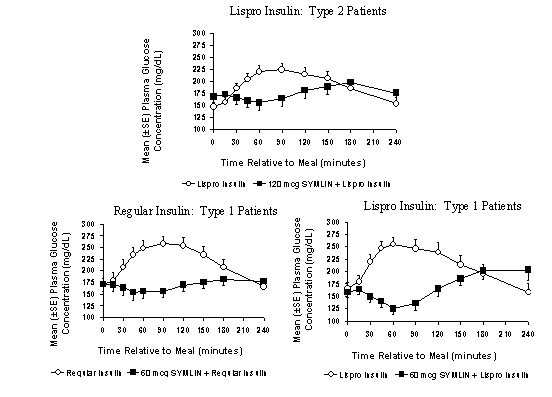
Reduced Food Intake
A single, subcutaneous dose of SYMLIN 120 mcg (type 2) or 30 mcg (type 1) administered 1 hour prior to an unlimited buffet meal was associated with reductions in total caloric intake (placebo-subtracted mean changes of ~23% and 21%, respectively), which occurred without decreases in meal duration.
CLINICAL STUDIES
A total of 5325 patients and healthy volunteers received SYMLIN in clinical studies. This includes 1688 with type 2 diabetes and 2375 with type 1 diabetes in short- and long-term controlled clinical trials, long-term uncontrolled clinical trials, and an open-label study in the clinical practice setting.
Clinical Studies in Type 2 Diabetes
The efficacy of a range of SYMLIN doses was evaluated in several placebo-controlled and open-label clinical trials in insulin-using patients with type 2 diabetes. Based on results obtained in these studies, the recommended dose of SYMLIN for patients with insulin-using type 2 diabetes is 120 mcg administered immediately prior to major meals.
Two, long-term (26 to 52 week), randomized, double-blind, placebo-controlled studies of SYMLIN were conducted in patients with type 2 diabetes using fixed dose insulin to isolate the SYMLIN effect. Demographic and baseline characteristics for the 871 SYMLIN-treated patients are as follows: mean baseline HbA1c ranged from 9.0 to 9.4%, mean age was 56.4 to 59.1 years, mean duration of diabetes ranged from 11.5 to 14.4 years, and mean BMI ranged from 30.1 to 34.4 kg/m2. In both of these studies, SYMLIN or placebo was added to the participants' existing diabetes therapies, which included insulin with or without a sulfonylurea agent and/or metformin.
Table 2 summarizes the composite results across both studies for patients assigned to the 120-mcg dose after 6 months of treatment.
| Variable | Placebo | SYMLIN (120 mcg) |
|---|---|---|
| Baseline HbA1c (%) | 9.3 (0.08) | 9.1 (0.06) |
| Change in HbA1c at 6 Months Relative to Baseline (%) | −0.17 (0.07) | −0.57 (0.06) |
| Placebo-Subtracted HbA1c Change at 6 Months (%) | NA | −0.40 (0.09) |
| Baseline Weight (kg) | 91.3 (1.2) | 92.5 (1.2) |
| Change in Weight at 6 Months Relative to Baseline (kg) | +0.2 (0.2) | −1.5 (0.2) |
| Placebo-Subtracted Weight Change at 6 Months (kg) | NA | −1.7 (0.3) |
| Percent Change in Insulin Doses at 6 Months: Rapid/Short-Acting | +6.5 (2.7) | −3.0 (1.6) |
| Percent Change in Insulin Doses at 6 Months: Long-Acting | +5.2 (1.4) | −0.2 (1.3) |
In a cohort of 145 patients who completed two years of SYMLIN treatment the baseline-subtracted HbA1c and weight reductions were: −0.40% and −0.36 kg, respectively.
Open-Label Study in the Clinical Practice Setting
An open-label study of SYMLIN was conducted at the recommended dose of 120 mcg in 166 patients with insulin-using type 2 diabetes who were unable to achieve glycemic targets using insulin alone. A flexible-dose insulin regimen was employed in these patients (see DOSAGE and ADMINISTRATION). In this study, patients adjusted their insulin regimen based on pre- and post-meal glucose monitoring. At baseline, mean HbA1c was 8.3%, mean age was 54.4 years, mean duration of diabetes was 13.3 years, and mean BMI was 38.6 kg/m2. SYMLIN was administered with major meals. SYMLIN plus insulin treatment for 6 months resulted in a baseline-subtracted mean HbA1c reduction of −0.56 ± 0.15% and a baseline-subtracted mean weight reduction of −2.76 ± 0.34 kg. These changes were accomplished with reductions in doses of total, short-acting, and long-acting insulin (−6.4 ± 2.66, −10.3 ± 4.84, and −4.20 ± 2.42%, respectively).
Clinical Studies in Type 1 Diabetes
The efficacy of a range of SYMLIN doses was evaluated in several placebo-controlled and open-label clinical trials conducted in patients with type 1 diabetes. Based on results obtained in these studies, the recommended dose of SYMLIN for patients with type 1 diabetes is 30 mcg or 60 mcg administered immediately prior to major meals.
Three, long-term (26 to 52 week), randomized, double-blind, placebo-controlled studies of SYMLIN were conducted in patients with type 1 diabetes (N=1717). Two of these studies allowed only minimal insulin adjustments in order to isolate the SYMLIN effect; in the third study, insulin adjustments were made according to standard medical practice. Demographic and baseline characteristics for the 1179 SYMLIN-treated patients were as follows: mean baseline HbA1c range was 8.7 to 9.0%, mean age range was 37.3 to 41.9 years, mean duration of diabetes range was 15.5 to 19.2 years, and mean BMI range was 25.0 to 26.8 kg/m2. SYMLIN or placebo was added to existing insulin therapies.
Table 3 summarizes the composite results across these studies for patients assigned to the 30 or 60 mcg dose after 6 months of treatment.
| Variable | Placebo | SYMLIN (30 or 60 mcg) |
|---|---|---|
| Baseline HbA1c (%) | 9.0 (0.06) | 8.9 (0.04) |
| Change in HbA1c at 6 Months Relative to Baseline (%) | −0.10 (0.05) | −0.43 (0.04) |
| Placebo-Subtracted HbA1c Change at 6 Months (%) | NA | −0.33 (0.06) |
| Baseline Weight (kg) | 75.1 (0.6) | 76.1 (0.5) |
| Change in Weight at 6 Months Relative to Baseline (kg) | +0.6 (0.1) | −1.1 (0.1) |
| Placebo-Subtracted Weight Change at 6 Months (kg) | NA | −1.7 (0.1) |
| Percent Change in Insulin Doses at 6 Months: Rapid/Short-Acting | +1.7 (3.3) | −3.6 (2.9) |
| Percent Change in Insulin Doses at 6 Months: Long-Acting | +2.5 (1.9) | +1.9 (1.3) |
In a cohort of 73 patients who completed two years of SYMLIN treatment the baseline-subtracted HbA1c and weight changes were: −0.35% and 0.60 kg, respectively.
SYMLIN Dose-Titration Trial
A dose-titration study of SYMLIN was conducted in patients with type 1 diabetes. Patients with relatively good baseline glycemic control (mean HbA1c = 8.1%) were randomized to receive either insulin plus placebo or insulin plus SYMLIN. Other baseline and demographics characteristics were: mean age of 41 years, mean duration of diabetes of 20 years, mean BMI of 28 kg/m2. SYMLIN was initiated at a dose of 15 mcg and titrated upward at weekly intervals by 15-mcg increments to doses of 30 mcg or 60 mcg, based on whether patients experienced nausea. Once a tolerated dose of either 30 mcg or 60 mcg was reached, the SYMLIN dose was maintained for the remainder of the study (SYMLIN was administered before major meals). During SYMLIN titration, the insulin dose (mostly the short/rapid-acting insulin) was reduced by 30-50% in order to reduce the occurrence of hypoglycemia. Once a tolerated SYMLIN dose was reached, insulin dose adjustments were made according to standard clinical practice, based on pre- and post-meal blood glucose monitoring. By 6 months of treatment, patients treated with SYMLIN and insulin and patients treated with insulin and placebo had equivalent reductions in mean HbA1c (−0.47 ± 0.07% vs. −0.49 ± 0.07%, respectively); patients on SYMLIN lost weight (−1.33 ± 0.31 kg relative to baseline and −2.6 kg relative to placebo plus insulin-treated patients). SYMLIN-treated patients used less total insulin (−11.7% relative to baseline) and less short/rapid-acting insulin (−22.8%) relative to baseline.
Open-Label Study in the Clinical Practice Setting
An open-label study of SYMLIN was conducted in patients with type 1 diabetes who were unable to achieve glycemic targets using insulin alone. A flexible-dose insulin regimen was employed in these patients after SYMLIN titration was completed (see DOSAGE and ADMINISTRATION). In this study, patients adjusted their insulin regimen based on pre- and post-meal glucose monitoring. At baseline, mean HbA1c was 8.0%, mean age was 42.7 years, mean duration of diabetes was 21.2 years, and mean BMI was 28.6 kg/m2. SYMLIN daily dosage was 30 mcg or 60 mcg with major meals.
SYMLIN plus insulin reduced HbA1c and body weight from baseline at 6 months by a mean of 0.18% and 3.0 kg, respectively. These changes in glycemic control and body weight were achieved with reductions in doses of total, short-acting, and long-acting insulin (−12.0 ± 1.36, −21.7 ± 2.81, and −0.4 ± 1.59%, respectively).
SYMLIN INDICATIONS AND USAGE
SYMLIN is given at mealtimes and is indicated for:
- Type 1 diabetes, as an adjunct treatment in patients who use mealtime insulin therapy and who have failed to achieve desired glucose control despite optimal insulin therapy.
- Type 2 diabetes, as an adjunct treatment in patients who use mealtime insulin therapy and who have failed to achieve desired glucose control despite optimal insulin therapy, with or without a concurrent sulfonylurea agent and/or metformin.
SYMLIN CONTRAINDICATIONS
SYMLIN is contraindicated in patients with any of the following:
- a known hypersensitivity to SYMLIN or any of its components, including metacresol;
- a confirmed diagnosis of gastroparesis;
- hypoglycemia unawareness.
WARNINGS
Patient Selection
Proper patient selection is critical to safe and effective use of SYMLIN
Before initiation of therapy, the patient's HbA1c, recent blood glucose monitoring data, history of insulin-induced hypoglycemia, current insulin regimen, and body weight should be reviewed. SYMLIN therapy should only be considered in patients with insulin-using type 2 or type 1 diabetes who fulfill the following criteria:
- have failed to achieve adequate glycemic control despite individualized insulin management;
- are receiving ongoing care under the guidance of a healthcare professional skilled in the use of insulin and supported by the services of diabetes educator(s).
Patients meeting any of the following criteria should NOT be considered for SYMLIN therapy:
- poor compliance with current insulin regimen;
- poor compliance with prescribed self-blood glucose monitoring;
- have an HbA1c > 9%;
- recurrent severe hypoglycemia requiring assistance during the past 6 months;
- presence of hypoglycemia unawareness;
- confirmed diagnosis of gastroparesis;
- require the use of drugs that stimulate gastrointestinal motility;
- pediatric patients.
Hypoglycemia
SYMLIN alone does not cause hypoglycemia. However, SYMLIN is indicated to be co-administered with insulin therapy and in this setting SYMLIN increases the risk of insulin-induced severe hypoglycemia, particularly in patients with type 1 diabetes. Severe hypoglycemia associated with SYMLIN occurs within the first 3 hours following a SYMLIN injection. If severe hypoglycemia occurs while operating a motor vehicle, heavy machinery, or while engaging in other high-risk activities, serious injuries may occur. Therefore, when introducing SYMLIN therapy, appropriate precautions need to be taken to avoid increasing the risk for insulin-induced severe hypoglycemia. These precautions include frequent pre- and post-meal glucose monitoring combined with an initial 50% reduction in pre-meal doses of short-acting insulin (see DOSAGE and ADMINISTRATION).
Symptoms of hypoglycemia may include hunger, headache, sweating, tremor, irritability, or difficulty concentrating. Rapid reductions in blood glucose concentrations may induce such symptoms regardless of glucose values. More severe symptoms of hypoglycemia include loss of consciousness, coma, or seizure.
Early warning symptoms of hypoglycemia may be different or less pronounced under certain conditions, such as long duration of diabetes; diabetic nerve disease; use of medications such as beta-blockers, clonidine, guanethidine, or reserpine; or intensified diabetes control.
The addition of any antihyperglycemic agent such as SYMLIN to an existing regimen of one or more antihyperglycemic agents (e.g., insulin, sulfonylurea), or other agents that can increase the risk of hypoglycemia may necessitate further insulin dose adjustments and particularly close monitoring of blood glucose.
The following are examples of substances that may increase the blood glucose-lowering effect and susceptibility to hypoglycemia: oral anti-diabetic products, ACE inhibitors, diisopyramide, fibrates, fluoxetine, MAO inhibitors, pentoxifylline, propoxyphene, salicylates, and sulfonamide antibiotics.
Clinical studies employing a controlled hypoglycemic challenge have demonstrated that SYMLIN does not alter the counter-regulatory hormonal response to insulin-induced hypoglycemia. Likewise, in SYMLIN-treated patients, the perception of hypoglycemic symptoms was not altered with plasma glucose concentrations as low as 45 mg/dL.
PRECAUTIONS
General
Hypoglycemia (See WARNINGS).
SYMLIN should be prescribed with caution to persons with visual or dexterity impairment.
Information for Patients
Healthcare providers should inform patients of the potential risks and advantages of SYMLIN therapy. Healthcare providers should also inform patients about self-management practices including glucose monitoring, proper injection technique, timing of dosing, and proper storage of SYMLIN. In addition, reinforce the importance of adherence to meal planning, physical activity, recognition and management of hypoglycemia and hyperglycemia, and assessment of diabetes complications. Refer patients to the SYMLIN Medication Guide and Patient Instructions for Use for additional information.
Instruct patients on handling of special situations such as intercurrent conditions (illness or stress), an inadequate or omitted insulin dose, inadvertent administration of increased insulin or SYMLIN dose, inadequate food intake or missed meals.
SYMLIN and insulin should always be administered as separate injections and never be mixed.
Women with diabetes should be advised to inform their healthcare professional if they are pregnant or contemplating pregnancy.
Renal Impairment
The dosing requirements for SYMLIN are not altered in patients with moderate or severe renal impairment (ClCr >20 to ≤50 mL/min). No studies have been done in dialysis patients (see CLINICAL PHARMACOLOGY; Special Populations).
Hepatic Impairment
Studies have not been performed in patients with hepatic impairment. However, hepatic dysfunction is not expected to affect blood concentrations of SYMLIN (see CLINICAL PHARMACOLOGY; Special Populations).
Allergy
Local Allergy
Patients may experience redness, swelling, or itching at the site of injection. These minor reactions usually resolve in a few days to a few weeks. In some instances, these reactions may be related to factors other than SYMLIN, such as irritants in a skin cleansing agent or improper injection technique.
Systemic Allergy
In controlled clinical trials up to 12 months, potential systemic allergic reactions were reported in 65 (5%) of type 2 patients and 59 (5%) of type 1 SYMLIN-treated patients. Similar reactions were reported by 18 (4%) and 28 (5%) of placebo-treated type 2 and type 1 patients, respectively. No patient receiving SYMLIN was withdrawn from a trial due to a potential systemic allergic reaction.
Drug Interactions
Due to its effects on gastric emptying, SYMLIN therapy should not be considered for patients taking drugs that alter gastrointestinal motility (e.g., anticholinergic agents such as atropine) and agents that slow the intestinal absorption of nutrients (e.g., α-glucosidase inhibitors). Patients using these drugs have not been studied in clinical trials.
SYMLIN has the potential to delay the absorption of concomitantly administered oral medications. When the rapid onset of a concomitant orally administered agent is a critical determinant of effectiveness (such as analgesics), the agent should be administered at least 1 hour prior to or 2 hours after SYMLIN injection.
In clinical trials, the concomitant use of sulfonylureas or biguanides did not alter the adverse event profile of SYMLIN. No formal interaction studies have been performed to assess the effect of SYMLIN on the kinetics of oral antidiabetic agents.
Mixing SYMLIN and Insulin
The pharmacokinetic parameters of SYMLIN were altered when mixed with regular, NPH, and 70/30 premixed formulations of recombinant human insulin immediately prior to injection. Thus, SYMLIN and insulin should not be mixed and must be administered separately.
Carcinogenesis, Mutagenesis, Impairment of Fertility
Carcinogenesis
A two-year carcinogenicity study was conducted in CD-1 mice with doses of 0.2, 0.5, and 1.2 mg/kg/day of SYMLIN (32, 67, and 159 times the exposure resulting from the maximum recommended human dose based on area under the plasma concentration curve or AUC, respectively). No drug-induced tumors were observed. A two-year carcinogenicity study was conducted in Sprague-Dawley rats with doses of 0.04, 0.2, and 0.5 mg/kg/day of SYMLIN (3, 9, and 25 times the exposure resulting from the maximum recommended human dose based on AUC, respectively). No drug-induced tumors were observed in any organ.
Mutagenesis
SYMLIN was not mutagenic in the Ames test and did not increase chromosomal aberration in the human lymphocytes assay. SYMLIN was not clastogenic in the in vivo mouse micronucleus test or in the chromosomal aberration assay utilizing Chinese hamster ovary cells.
Impairment of Fertility
Administration of 0.3, 1, or 3 mg/kg/day of SYMLIN (8, 17, and 82 times the exposure resulting from the maximum recommended human dose based on body surface area) had no significant effects on fertility in male or female rats. The highest dose of 3 mg/kg/day resulted in dystocia in 8/12 female rats secondary to significant decreases in serum calcium levels.
Pregnancy
Teratogenic Effects: Pregnancy Category C
No adequate and well-controlled studies have been conducted in pregnant women. Studies in perfused human placenta indicate that SYMLIN has low potential to cross the maternal/fetal placental barrier. Embryofetal toxicity studies with SYMLIN have been performed in rats and rabbits. Increases in congenital abnormalities (neural tube defect, cleft palate, exencephaly) were observed in fetuses of rats treated during organogenesis with 0.3 and 1.0 mg/kg/day (10 and 47 times the exposure resulting from the maximum recommended human dose based on AUC, respectively). Administration of doses up to 0.3 mg/kg/day SYMLIN (9 times maximum recommended dose based on AUC) to pregnant rabbits had no adverse effects in embryofetal development; however, animal reproduction studies are not always predictive of human response. SYMLIN should be used during pregnancy only if it is determined by the healthcare professional that the potential benefit justifies the potential risk to the fetus.
Nursing Mothers
It is unknown whether SYMLIN is excreted in human milk. Many drugs, including peptide drugs, are excreted in human milk. Therefore, SYMLIN should be administered to nursing women only if it is determined by the healthcare professional that the potential benefit outweighs the potential risk to the infant.
Pediatric Use
Safety and effectiveness of SYMLIN in pediatric patients have not been established.
Geriatric Use
SYMLIN has been studied in patients ranging in age from 15 to 84 years of age, including 539 patients 65 years of age or older. The change in HbA1c values and hypoglycemia frequencies did not differ by age, but greater sensitivity in some older individuals cannot be ruled out. Thus, both SYMLIN and insulin regimens should be carefully managed to obviate an increased risk of severe hypoglycemia.
SYMLIN ADVERSE REACTIONS
Adverse events (excluding hypoglycemia, discussed below) commonly associated with SYMLIN when co-administered with a fixed dose of insulin in the long-term, placebo-controlled trials in insulin-using type 2 patients and type 1 patients are presented in Table 4 and Table 5, respectively. The same adverse events were also shown in the open-label clinical practice study, which employed flexible insulin dosing.
| Long-Term, Placebo-Controlled Studies | Open-Label, Clinical Practice Study | ||
|---|---|---|---|
| Placebo + Insulin (n(%)) (N=284) |
SYMLIN + Insulin (n(%)) (N=292) |
SYMLIN + Insulin (n(%)) (N=166) |
|
| Nausea | 34 (12) | 81 (28) | 53 (30) |
| Headache | 19 (7) | 39 (13) | 8 (5) |
| Anorexia | 5 (2) | 27 (9) | 1 (<1) |
| Vomiting | 12 (4) | 24 (8) | 13 (7) |
| Abdominal Pain | 19 (7) | 23 (8) | 3 (2) |
| Fatigue | 11 (4) | 20 (7) | 5 (3) |
| Dizziness | 11 (4) | 17 (6) | 3 (2) |
| Coughing | 12 (4) | 18 (6) | 4 (2) |
| Pharyngitis | 7 (2) | 15 (5) | 6 (3) |
| Long-Term, Placebo-Controlled Studies | Open-Label, Clinical Practice Study | ||
|---|---|---|---|
| Placebo + Insulin (n(%)) (N=538) |
SYMLIN + Insulin (n(%)) (N=716) |
SYMLIN + Insulin (n(%)) (N=265) |
|
| Nausea | 92 (17) | 342 (48) | 98 (37) |
| Anorexia | 12 (2) | 122 (17) | 0 (0) |
| Inflicted Injury | 55 (10) | 97 (14) | 20 (8) |
| Vomiting | 36 (7) | 82 (11) | 18 (7) |
| Arthralgia | 27 (5) | 51 (7) | 6 (2) |
| Fatigue | 22 (4) | 51 (7) | 12 (4.5) |
| Allergic Reaction | 28 (5) | 41 (6) | 1 (<1) |
| Dizziness | 21 (4) | 34 (5) | 5 (2) |
Most adverse events were gastrointestinal in nature. In patients with type 2 or type 1 diabetes, the incidence of nausea was higher at the beginning of SYMLIN treatment and decreased with time in most patients. The incidence and severity of nausea are reduced when SYMLIN is gradually titrated to the recommended doses (see DOSAGE and ADMINISTRATION).
Severe Hypoglycemia
SYMLIN alone (without the concomitant administration of insulin) does not cause hypoglycemia. However, SYMLIN is indicated as an adjunct treatment in patients who use mealtime insulin therapy and co-administration of SYMLIN with insulin can increase the risk of insulin-induced hypoglycemia, particularly in patients with type 1 diabetes (see Boxed Warning). The incidence of severe hypoglycemia during the SYMLIN clinical development program is summarized in Table 6 and Table 7.
| Long-Term, Placebo-Controlled Studies (No Insulin Dose-Reduction During Initiation) |
Open-Label, Clinical Practice Study (Insulin Dose-Reduction During Initiation) |
|||||
|---|---|---|---|---|---|---|
| Placebo + Insulin | SYMLIN + Insulin | SYMLIN + Insulin | ||||
|
Severe Hypoglycemia |
0-3 Months (n=284) |
>3-6 Months (n=251) |
0-3 Months (n=292) |
>3-6 Months (n=255) |
0-3 Months (n=166) |
>3-6 Months (n=150) |
| Patient-Ascertained |
||||||
| Event Rate (event rate/patient year) | 0.24 | 0.13 | 0.45 | 0.39 | 0.05 | 0.03 |
| Incidence (%) | 2.1 | 2.4 | 8.2 | 4.7 | 0.6 | 0.7 |
| Medically Assisted |
||||||
| Event Rate (event rate/patient year) | 0.06 | 0.07 | 0.09 | 0.02 | 0.05 | 0.03 |
| Incidence (%) | 0.7 | 1.2 | 1.7 | 0.4 | 0.6 | 0.7 |
|
Long-Term, Placebo-Controlled Studies (No Insulin Dose-Reduction During Initiation) |
Open-Label, Clinical Practice Study (Insulin Dose-Reduction During Initiation) |
|||||
|---|---|---|---|---|---|---|
| Placebo + Insulin | SYMLIN + Insulin | SYMLIN + Insulin | ||||
|
Severe Hypoglycemia |
0-3 Months (n=538) |
>3-6 Months (n=470) |
0-3 Months (n=716) |
>3-6 Months (n=576) |
0-3 Months (n=265) |
>3-6 Months (n=213) |
| Patient-Ascertained |
||||||
| Event Rate (event rate/patient year) | 1.33 | 1.06 | 1.55 | 0.82 | 0.29 | 0.16 |
| Incidence (%) | 10.8 | 8.7 | 16.8 | 11.1 | 5.7 | 3.8 |
| Medically Assisted |
||||||
| Event Rate (event rate/patient year) | 0.19 | 0.24 | 0.50 | 0.27 | 0.10 | 0.04 |
| Incidence (%) | 3.3 | 4.3 | 7.3 | 5.2 | 2.3 | 0.9 |
Post Marketing Experience
Since market introduction of SYMLIN, the following adverse reactions have been reported. Because these events are reported voluntarily from a population of uncertain size, it is not always possible to reliably estimate their frequency or establish a causal relationship to drug exposure.
General: Injection site reactions.
OVERDOSAGE
Single 10 mg doses of SYMLIN (83 times the maximum dose of 120 mcg) were administered to three healthy volunteers. Severe nausea was reported in all three individuals and was associated with vomiting, diarrhea, vasodilatation, and dizziness. No hypoglycemia was reported. SYMLIN has a short half-life and in the case of overdose, supportive measures are indicated.
SYMLIN DOSAGE AND ADMINISTRATION
SYMLIN dosage differs depending on whether the patient has type 2 or type 1 diabetes (see below). When initiating therapy with SYMLIN, initial insulin dose reduction is required in all patients (both type 2 and type 1) to reduce the risk of insulin-induced hypoglycemia. As this reduction in insulin can lead to glucose elevations, patients should be monitored at regular intervals to assess SYMLIN tolerability and the effect on blood glucose, so that individualized insulin adjustments can be initiated. If SYMLIN therapy is discontinued for any reason (e.g., surgery or illnesses), the same initiation protocol should be followed when SYMLIN therapy is re-instituted (see below).
Initiation of SYMLIN therapy
Patients With Insulin-Using Type 2 Diabetes
In patients with insulin-using type 2 diabetes, SYMLIN should be initiated at a dose of 60 mcg and increased to a dose of 120 mcg as tolerated.
Patients should be instructed to:
- Initiate SYMLIN at 60 mcg subcutaneously, immediately prior to major meals;
- Reduce preprandial, rapid-acting or short-acting insulin dosages, including fixed-mix insulins (70/30) by 50%;
- Monitor blood glucose frequently, including pre- and post-meals and at bedtime;
- Increase the SYMLIN dose to 120 mcg when no clinically significant nausea has occurred for 3-7 days. SYMLIN dose adjustments should be made only as directed by the healthcare professional. If significant nausea persists at the 120 mcg dose, the SYMLIN dose should be decreased to 60 mcg;
- Adjust insulin doses to optimize glycemic control once the target dose of SYMLIN is achieved and nausea (if experienced) has subsided. Insulin dose adjustments should be made only as directed by the healthcare professional;
- Contact a healthcare professional skilled in the use of insulin to review SYMLIN and insulin dose adjustments at least once a week until a target dose of SYMLIN is achieved, SYMLIN is well-tolerated, and blood glucose concentrations are stable.
Patients With Type 1 Diabetes
In patients with type 1 diabetes, SYMLIN should be initiated at a dose of 15 mcg and titrated at 15-mcg increments to a maintenance dose of 30 mcg or 60 mcg as tolerated.
Patients should be instructed to:
- Initiate SYMLIN at a starting dose of 15 mcg subcutaneously, immediately prior to major meals;
- Reduce preprandial, rapid-acting or short-acting insulin dosages, including fixed-mix insulins (e.g., 70/30) by 50%;
- Monitor blood glucose frequently, including pre- and post-meals and at bedtime;
- Increase the SYMLIN dose to the next increment (30 mcg, 45 mcg, or 60 mcg) when no clinically significant nausea has occurred for at least 3 days. SYMLIN dose adjustments should be made only as directed by the healthcare professional. If significant nausea persists at the 45 or 60 mcg dose level, the SYMLIN dose should be decreased to 30 mcg. If the 30 mcg dose is not tolerated, discontinuation of SYMLIN therapy should be considered;
- Adjust insulin doses to optimize glycemic control once the target dose of SYMLIN is achieved and nausea (if experienced) has subsided. Insulin dose adjustments should be made only as directed by the healthcare professional;
- Contact a healthcare professional skilled in the use of insulin to review SYMLIN and insulin dose adjustments at least once a week until a target dose of SYMLIN is achieved, SYMLIN is well-tolerated, and blood glucose concentrations are stable.
Once Target Dose of SYMLIN is Achieved in Type 2 or Type 1 Patients
After a maintenance dose of SYMLIN is achieved, both insulin-using patients with type 2 diabetes and patients with type 1 diabetes should be instructed to:
- Adjust insulin doses to optimize glycemic control once the target dose of SYMLIN is achieved and nausea (if experienced) has subsided. Insulin dose adjustments should be made only as directed by a healthcare professional;
- Contact a healthcare professional in the event of recurrent nausea or hypoglycemia. An increased frequency of mild to moderate hypoglycemia should be viewed as a warning sign of increased risk for severe hypoglycemia.
Administration
SYMLIN should be administered subcutaneously immediately prior to each major meal (≥250 kcal or containing ≥30 g of carbohydrate).
SYMLIN should be at room temperature before injecting to reduce potential injection site reactions. Each SYMLIN dose should be administered subcutaneously into the abdomen or thigh (administration into the arm is not recommended because of variable absorption). Injection sites should be rotated so that the same site is not used repeatedly. The injection site selected should also be distinct from the site chosen for any concomitant insulin injection.
- SYMLIN and insulin should always be administered as separate injections.
- SYMLIN should not be mixed with any type of insulin.
- If a SYMLIN dose is missed, wait until the next scheduled dose and administer the usual amount.
The SymlinPen® pen-injector is available in two presentations:
- SymlinPen® 60 pen-injector for doses of 15 mcg, 30 mcg, 45 mcg, 60 mcg.
- SymlinPen® 120 pen-injector for doses of 60 mcg and 120 mcg.
See the accompanying Patient Instructions for Use for instructions for using the SymlinPen® pen-injector.
The patient should be advised:
- to confirm they are using the correct pen-injector that will deliver their prescribed dose;
- on proper use of the pen-injector, emphasizing how and when to set up a new pen-injector;
- not to transfer SYMLIN from the pen-injector to a syringe. Doing so could result in a higher dose than intended, because SYMLIN in the pen-injector is a higher concentration than SYMLIN in the SYMLIN vial;
- not to share the pen-injector and needles with others;
- that needles are not included with the pen-injector and must be purchased separately;
- which needle length and gauge should be used;
- to use a new needle for each injection.
To administer SYMLIN from vials, use a U-100 insulin syringe (preferably a 0.3 mL [0.3 cc] size) for optimal accuracy. If using a syringe calibrated for use with U-100 insulin, use the chart below (Table 8) to measure the microgram dosage in unit increments.
| Dosage Prescribed (mcg) | Increment Using a U-100 Syringe (Units) | Volume (cc or mL) |
|---|---|---|
| 15 | 2½ | 0.025 |
| 30 | 5 | 0.05 |
| 45 | 7½ | 0.075 |
| 60 | 10 | 0.1 |
| 120 | 20 | 0.2 |
Always use separate, new syringes and needles to give SYMLIN and insulin injections.
Discontinuation of Therapy
SYMLIN therapy should be discontinued if any of the following occur:
- Recurrent unexplained hypoglycemia that requires medical assistance;
- Persistent clinically significant nausea;
- Noncompliance with self-monitoring of blood glucose concentrations;
- Noncompliance with insulin dose adjustments;
- Noncompliance with scheduled healthcare professional contacts or recommended clinic visits.
Preparation and Handling
SYMLIN should be inspected visually for particulate matter or discoloration prior to administration whenever the solution and the container permit.
HOW SUPPLIED
SYMLIN is supplied as a sterile injection in the following dosage forms:
- 1.5 mL disposable multidose SymlinPen® 60 pen-injector containing 1000 mcg/mL pramlintide (as acetate).
- 2.7 mL disposable multidose SymlinPen® 120 pen-injector containing 1000 mcg/mL pramlintide (as acetate).
- 5 mL vial, containing 600 mcg/mL pramlintide (as acetate), for use with an insulin syringe.
To administer SYMLIN from vials, use a U-100 insulin syringe (preferably a 0.3 mL [0.3 cc] size). If using a syringe calibrated for use with U-100 insulin, use the chart (Table 8) in the DOSAGE AND ADMINISTRATION section to measure the microgram dosage in unit increments.
Do not mix SYMLIN with insulin.
SYMLIN Injection is available in the following package sizes:
- SymlinPen® 60 pen-injector, containing 1000 mcg/mL pramlintide (as acetate)
2 X 1.5 mL disposable multidose pen-injector
(NDC 66780-115-02) - SymlinPen® 120 pen-injector, containing 1000 mcg/mL pramlintide (as acetate)
2 X 2.7 mL disposable multidose pen-injector
(NDC 66780-121-02) - 5 mL vial, containing 600 mcg/mL pramlintide (as acetate), for use with an insulin syringe
(NDC 66780-110-01)
STORAGE
SYMLIN pen-injectors and vials not in use: Refrigerate (36°F to 46°F; 2°C to 8°C), and protect from light. Do not freeze. Do not use if product has been frozen. Unused SYMLIN (opened or unopened) should not be used after the expiration (EXP) date printed on the carton and the label.
SYMLIN pen-injectors and vials in use: After first use, refrigerate or keep at a temperature not greater than 86°F (30°C) for 30 days. Use within 30 days, whether or not refrigerated.
Storage conditions are summarized in Table 9.
| Dosage Form | Unopened (not in use) Refrigerated |
Open (in use) Refrigerated or Temperature Up To 86°F (30°C) |
|---|---|---|
| 1.5 mL pen-injector 2.7 mL pen-injector 5 mL vial |
Until Expiration Date | Use Within 30 days |
The SymlinPen® pen-injectors and SYMLIN vials are manufactured for:
Amylin Pharmaceuticals, Inc.
San Diego, CA 92121 USA
1-800-349-8919
http://www.SYMLIN.com
Rx only
The SYMLIN mark, SYMLIN design mark, and SymlinPen are registered trademarks of Amylin Pharmaceuticals, Inc. Copyright © 2005-2008, Amylin Pharmaceuticals, Inc. All rights reserved.
Literature Revised July 2008
812003-CC
Medication Guide
SYMLIN®
(SĬM-lĭn)
(pramlintide acetate) injection
Read the Medication Guide and the "Patient Instructions for Use" that come with your SYMLIN product before you start using it and each time you get a refill. There may be new information. This Medication Guide does not take the place of talking to your doctor about your medical condition or treatment.
|
What is the most important information I should know about SYMLIN?
|
What is SYMLIN?
SYMLIN is an injectable medicine for adults with type 2 and type 1 diabetes to control blood sugar. SYMLIN slows down the movement of food through your stomach. This affects how fast sugar enters your blood after eating. SYMLIN is always used with insulin to help lower blood sugar during the 3 hours after meals.
Who should not use SYMLIN?
Do not use SYMLIN if you:
- cannot tell when your blood sugar is low (hypoglycemia unawareness).
- have a stomach problem called gastroparesis. This is when your stomach does not empty as fast as it should.
- are allergic to SYMLIN or any ingredients in SYMLIN. See the end of this Medication Guide for a complete list of ingredients.
SYMLIN has not been studied in children.
What should I tell my doctor before starting SYMLIN?
Tell your doctor about all of your medical conditions including if you:
- are pregnant or planning to become pregnant. It is not known if SYMLIN can harm your unborn baby. You and your doctor will decide how to best control your blood sugar levels during pregnancy.
- are breastfeeding. It is not known if SYMLIN passes into your milk and if it can harm your baby. You and your doctor will decide the best way to feed your baby if you are using SYMLIN.
Keep a list of all the medicines you take. Tell your doctor about all the medicines you take including prescription and non-prescription medicines, vitamins, and herbal supplements. SYMLIN can slow down how other medicines pass through your stomach and may affect how much of them get into your body. You may have to change the times you take certain medicines.
How should I use SYMLIN?
- You must use SYMLIN exactly as prescribed. The amount of SYMLIN you use will depend on whether you have type 2 or type 1 diabetes. You and your doctor will decide if you can use SYMLIN.
- It is important for you to carefully read, understand and follow the "Patient Instructions for Use" that comes along with this Medication Guide and your SYMLIN.
-
SYMLIN is available in vials and two SymlinPen® pen-injectors. Your doctor will prescribe the type of SYMLIN that is right for you.
- If you have been using the SYMLIN vial with an insulin syringe and you are changing to the SymlinPen® pen-injector: Your doctor will prescribe the SymlinPen® pen-injector that is right for you, tell you how much SYMLIN to inject and when to inject it.
- It is important that you understand how to inject the right SYMLIN dose. Read the "Patient Instructions for Use" carefully BEFORE giving your first dose with the SymlinPen® pen-injector. The SYMLIN in the pen-injector is a different strength than the SYMLIN in the vial.
- The way you inject SYMLIN is similar to the way you inject insulin. Inject SYMLIN under the skin (subcutaneously) of your stomach area (abdomen) or upper leg (thigh). Inject SYMLIN at a site that is more than 2 inches away from your insulin injection. Do not inject SYMLIN and insulin in the same site.
- To help reduce the chances of getting a reaction at the injection site, allow SYMLIN to come to room temperature before injecting.
- Use a new needle for each SYMLIN injection.
- Never mix SYMLIN and insulin. Insulin can affect SYMLIN when the two are mixed together.
- Do not use SYMLIN if the liquid looks cloudy.
- If you take more than your prescribed dose of SYMLIN, you may get nauseous or vomit, and you may not be able to eat the amount of food you usually eat. If you take more SYMLIN than your prescribed dose, pay careful attention to the amount of insulin you use because you may be at more risk for low blood sugar. Contact your doctor for guidance.
- If you miss or forget a dose of SYMLIN, wait until the next meal and take your usual dose of SYMLIN at that meal. Do not take more than your usual dose of SYMLIN.
Using SYMLIN and insulin with Type 2 Diabetes
- Start SYMLIN at 60 mcg injected under your skin, just before major meals. A major meal must have at least 250 calories or 30 grams of carbohydrate.
- Reduce your rapid-acting or short-acting insulin, including fixed-mix insulin such as 70/30, used before meals by 50 percent. This means half of the dose you usually use.
- You must check your blood sugar before and after every meal and at bedtime.
- Increase your dose of SYMLIN to 120 mcg on your doctor's instructions if you have not had any nausea for 3 days or more.
- Tell your doctor right away if you have nausea with the 120 mcg dose. Your doctor will tell you how to adjust your dose of SYMLIN.
- Your doctor may make changes to your insulin doses to better control your blood sugar once you are using the 120 mcg dose of SYMLIN. All insulin changes should be directed by your doctor.
Using SYMLIN and insulin with Type 1 Diabetes
- Start SYMLIN at 15 mcg injected under your skin, just before major meals. A major meal must have at least 250 calories or 30 grams of carbohydrate.
- When starting SYMLIN, reduce your rapid-acting or short-acting insulin, including fixed-mix insulin such as 70/30, used before meals by 50 percent. This means half of the dose you usually use. All insulin changes should be directed by your doctor.
- You must check your blood sugar before and after every meal and at bedtime.
- Increase your dose of SYMLIN to 30 mcg on your doctor's instructions if you have not had any nausea for 3 days or more. If you have nausea with SYMLIN at 30 mcg, call your doctor right away. Your doctor may decide that you should stop SYMLIN.
- Increase your dose of SYMLIN to 45 mcg on your doctor's instructions if you have not had any nausea for 3 days or more while using the 30 mcg dose.
- Increase your dose of SYMLIN to 60 mcg on your doctor's instructions if you have not had any nausea for 3 days or more while using the 45 mcg dose.
- Call your doctor right away if you are bothered with nausea on the 45 mcg or 60 mcg dose. Your doctor may decide that you should reduce SYMLIN to the 30 mcg dose.
- Your doctor may make changes to your insulin doses to better control your blood sugar once you are on a dose of SYMLIN that is right for you. All insulin changes should be directed by your doctor.
Staying on SYMLIN
- Once you reach your recommended dose of SYMLIN, talk to your doctor about changing your insulin doses to better control your blood sugar. You may have to increase your long-acting insulin to prevent high blood sugar (hyperglycemia) between meals. Insulin changes should always be directed by your doctor based on blood sugar testing.
- Call your doctor if nausea or low blood sugar continues while on your recommended dose of SYMLIN. Low blood sugar that happens often is a warning sign of possible severe low blood sugar, especially if you have type 1 diabetes.
- If you stop taking SYMLIN for any reason, such as surgery or illness, talk to your doctor about how to re-start SYMLIN.
When should I not use SYMLIN?
Do not use SYMLIN if:
- your blood sugar is too low.
- you do not plan to eat. Do not inject SYMLIN if you skip a meal.
- you plan to eat a meal with less than 250 calories or 30 grams of carbohydrate.
- you are sick and can't eat your usual meal.
- you are having surgery or a medical test where you cannot eat.
- you are pregnant or breastfeeding and have not talked to your doctor.
Talk to your doctor if you have any of these conditions.
What should I avoid while taking SYMLIN?
- Do not drive or operate dangerous machinery until you know how SYMLIN affects your blood sugar. Low blood sugar makes it hard to think clearly, drive a car, use heavy machinery or do other risky activities where you could hurt yourself or others. Discuss with your doctor what activities you should avoid.
- Alcohol may increase the risk of low blood sugar.
- Your doctor will tell you which medicines you can take while using SYMLIN. Do not take other medicines that slow stomach emptying.
What are the possible side effects of SYMLIN?
Low blood sugar (hypoglycemia)
- SYMLIN is used with insulin to lower your blood sugar, but your blood sugar may drop too low, especially if you have type 1 diabetes. See "What is the most important information I should know about SYMLIN?"
- When starting SYMLIN, reduce your doses of insulin before meals as recommended by your doctor to reduce the chance of low blood sugar. You and your doctor should talk about a plan to treat low blood sugar. You should have fast-acting sugar (such as hard candy, glucose tablets, juice) or glucagon with you at all times. Call your doctor if you have low blood sugar more often than normal or severe low blood sugar.
Your chance for low blood sugar is higher if you:- do not reduce your insulin dose before meals at the beginning of SYMLIN treatment, as directed by your doctor.
- use more SYMLIN or insulin than prescribed by your doctor.
- change your insulin dose without checking your blood sugar.
- eat less food than your usual meal.
- are sick and cannot eat.
- are more active than usual.
- have a low blood sugar level before eating.
- drink alcohol.
Always have fast-acting sugar (such as hard candy, glucose tablets, juice) or glucagon available to treat low blood sugar.
Nausea
Nausea is the most common side effect with SYMLIN. Mild nausea is more likely during the first weeks after starting SYMLIN and usually does not last long. It is very important to start SYMLIN at a low dose and increase it as directed by your doctor. See "How should I use SYMLIN?" If nausea continues or bothers you, call your doctor right away.
Other Side Effects
SYMLIN also may cause the following side effects: decreased appetite, vomiting, stomach pain, tiredness, dizziness, or indigestion.
SYMLIN also can cause reactions at the injection site including redness, minor bruising, or pain. See the detailed "Patient Instructions for Use." Follow the directions under "How should I use SYMLIN?" to reduce the chance of an injection site reaction.
Tell your doctor if you have any side effects that bother you or that do not go away.
These are not all the side effects with SYMLIN. Ask your doctor or pharmacist for more information.
How should I store SYMLIN?
- Store SYMLIN that has not been opened in the refrigerator, between 36°F to 46°F (2°C to 8°C), until you are ready to use it. Protect SYMLIN from light.
- After a vial or pen-injector has been used for the first time, it can be refrigerated or kept at a temperature up to 86°F (30°C) for 30 days. Do not leave above 86°F (30°C). Any vial or pen-injector in use should be thrown away after 30 days, even if it still has medicine in it.
- Unused SYMLIN (opened or unopened) should not be used after the expiration (EXP) date printed on the carton and the label.
- Do not freeze SYMLIN. Do not use SYMLIN if it has been frozen.
Keep SYMLIN and all medicines out of the reach of children.
General information about the safe and effective use of SYMLIN
Medicines are sometimes prescribed for purposes other than those listed in a Medication Guide. Do not use SYMLIN for a condition for which it was not prescribed. Do not give SYMLIN to other people, even if they have the same symptoms that you have. It may harm them.
This Medication Guide summarizes the most important information about SYMLIN. Also see the "Patient Instructions for Use" on using the SymlinPen® pen-injector or vial. You can ask your doctor for more about SYMLIN, including information that is written for doctors.
More information on SYMLIN can be found at http://www.SYMLIN.com.
SYMLIN Customer Service is available 24 hours a day at 1-800-349-8919.
Call your doctor for medical advice about side effects. You may report side effects to FDA at 1-800-FDA-1088.
What are the ingredients in SYMLIN?
Active ingredient: pramlintide acetate
Inactive ingredients: metacresol, D-mannitol, acetic acid, and sodium acetate.
This Medication Guide has been approved by the U.S. Food and Drug Administration.
Literature Revised July 2008
Manufactured for Amylin Pharmaceuticals, Inc.
San Diego CA 92121, USA
1-800-349-8919
http://www.SYMLIN.com
SYMLIN and SymlinPen are registered trademarks of Amylin Pharmaceuticals, Inc. Copyright © 2005-2008, Amylin Pharmaceuticals, Inc. All rights reserved.
813006-FF

These instructions do not take the place of talking with your doctor about your diabetes treatment. Ask your doctor about your dose and preferred injection technique. If you have questions or concerns about SYMLIN, please visit www.SYMLIN.com or call Amylin Customer Support toll free at 1-800-349-8919.

- Inspect your SYMLIN vial. The liquid in the vial should be clear and colorless.
- Check the expiration date (EXP) on the label to be sure your SYMLIN is not expired (see Figure A).
- Clean the top of the SYMLIN vial with an alcohol swab.
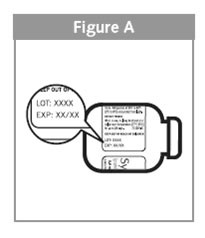
- Pull the plunger of the syringe to the line that matches your SYMLIN dose (see SYMLIN Dosing Chart and Figure B). The amount of air in the syringe should equal the amount of SYMLIN you plan to take.
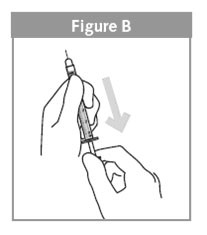
- Push the needle through the center of the rubber top of the SYMLIN vial (see Figure C).
- Push the plunger to inject the air into the vial.
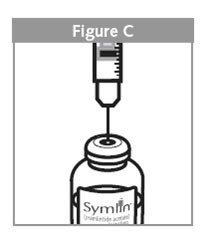
- Turn the vial and syringe upside down.
- Slowly pull the plunger down to draw the SYMLIN into the syringe until you have your correct dose (see Figure D).
- BEFORE removing the syringe from the vial, look for air bubbles inside the syringe. If you see bubbles, push the SYMLIN back into the vial. Then slowly pull the plunger down to draw the SYMLIN into the syringe until you have your correct dose.
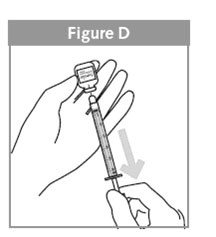
- Check to be sure your dose is correct, then remove the syringe from the vial.
- Give your injection as directed by your healthcare provider.
- Dispose of the used syringe as directed by your healthcare provider.

- Store SYMLIN that has not been opened in the refrigerator, between 36°F to 46°F (2°C to 8°C), until you are ready to use it. Protect SYMLIN from light.
- After a vial has been used for the first time, it can be refrigerated or kept at a temperature up to 86°F (30°C) for 30 days. Do not leave above 86°F (30°C).
- Any vial in use should be thrown away after 30 days, even if it still has medicine in it.
- Unused SYMLIN (opened or unopened) should not be used after the expiration (EXP) date printed on the carton and the label.
- Do not freeze SYMLIN. Do not use SYMLIN if it has been frozen.
- Keep SYMLIN and all medicines out of the reach of children.

- The way you inject SYMLIN is similar to the way you inject insulin. Inject SYMLIN under the skin (subcutaneously) of your stomach area (abdomen) or upper leg (thigh). Inject SYMLIN at a site that is more than 2 inches away from your insulin injection. To help reduce the chances of getting a reaction at the injection site, allow SYMLIN to come to room temperature before injecting. Also, use a new needle for each SYMLIN injection.
- If you take more than your prescribed dose of SYMLIN, you may get nauseous or vomit, and you may not be able to eat the amount of food you usually eat. Pay careful attention to the amount of insulin you use at this time as you may be at more risk for low blood sugar. Contact your doctor for guidance.
- If you miss or forget a dose of SYMLIN, wait until the next meal and take your usual dose of SYMLIN at that meal. Do not take more than your usual dose of SYMLIN.
- Never mix SYMLIN and insulin. Use different syringes for SYMLIN and insulin. Insulin can affect SYMLIN when the two are mixed together.
- Your prescription may be written in micrograms, and your insulin syringe is labeled in units. Use the chart below to convert micrograms to units.
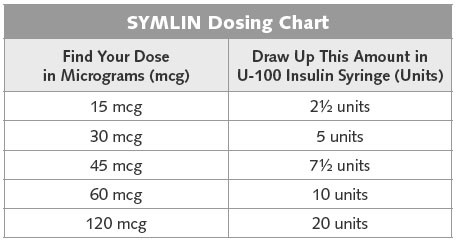
Literature Issued September 2007
815004-BB



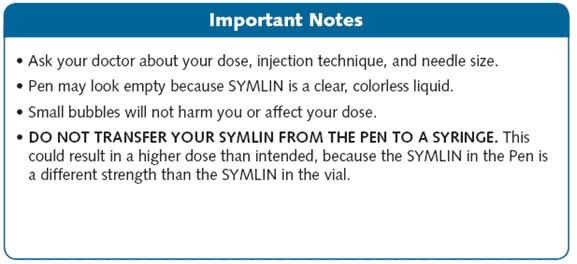
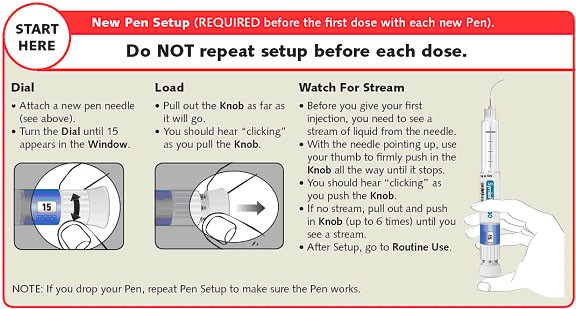

Literature Revised July 2008
SymlinPen® pen-injector (Pen)
Read these instructions carefully before using your Pen. Failure to follow these instructions may cause an incorrect dose, a broken Pen, or an infection.
- Check Pen label before each use to make sure you have the 15•30•45•60 mcg Pen.
- Check the expiration date (EXP) on the Pen label (see Pen Parts), and make sure the Pen is not expired.
- If you drop your Pen, go to New Pen Setup to confirm Pen works.
- If any part of your Pen appears broken or damaged, do not use.
- This Pen is not recommended for use by blind or visually impaired persons without the assistance of a person trained in the proper use of this Pen.
- If SYMLIN in the Cartridge (see Pen Parts) is not clear, colorless, and free of particles, do not use Pen.
Needles
- Use a new needle for each injection. Remove the needle from the Pen after completing each injection. This will help prevent leakage of SYMLIN, keep out air bubbles, reduce needle clogs, and reduce risk of infection.
- Pen needles are not included with the Pen. Use 29, 30, or 31 gauge disposable needles with the Pen. Ask your healthcare provider which needle gauge and length is best for you.
- Do not share your Pen or needles with anyone.
- Be sure the needle is completely attached to the Pen before use (see Attach Pen Needle). Do not push the Knob unless a needle is attached to Pen.
- Throw away used needles in a puncture-resistant container or as directed by your healthcare provider. Do not throw away the Pen with a needle attached.
- Follow local or institutional policies regarding needle handling and disposal.
Care and Storage
- Pen that has never been used:
- Refrigerate (36°F to 46°F, 2°C to 8°C).
- Protect from light.
- Do not freeze. Do not use a Pen that has been frozen.
- Pen in use:
- After the Pen is used for the first time (first use), refrigerate or keep at a temperature up to 86°F (30°C) for 30 days. Throw away Pen 30 days after first use, even if it still has SYMLIN in it.
- Pen should not be used after the expiration (EXP) date printed on the label.
- Do not store Pen with needle attached, or with Knob pulled out.
- If needed, wipe only the outside of Pen with a clean, damp cloth (water only).
- White particles may appear where the needle attaches during normal use. You may remove the particles with an alcohol wipe or alcohol swab.
- Keep Pen and needles out of the reach of children.
About SYMLIN
- The way you inject SYMLIN is similar to the way you inject insulin. Inject SYMLIN under the skin (subcutaneously) of your stomach area (abdomen) or upper leg (thigh). Inject SYMLIN at a site that is more than 2 inches away from your insulin injection. To help reduce the chances of getting a reaction at the injection site, allow SYMLIN to come to room temperature before injecting. Also, use a new needle for each SYMLIN injection.
- If you take more than your prescribed dose of SYMLIN, you may get nauseous or vomit, and you may not be able to eat the amount of food you usually eat. Pay careful attention to the amount of insulin you use at this time as you may be at more risk for low blood sugar. Contact your doctor for guidance.
- If you miss or forget a dose of SYMLIN, wait until the next meal and take your usual dose of SYMLIN at that meal. Do not take more than your usual dose of SYMLIN.
Questions and Answers (Q&A)
Why does my new Pen look empty?
- Because SYMLIN is clear and colorless, the Cartridge (see Pen Parts) may look empty, even though there is medicine in it.
- To be sure there is SYMLIN in the Cartridge, perform Pen setup (see New Pen Setup).
What should I do if I see air bubbles?
- The Cartridge may contain small air bubbles. Small air bubbles are normal and will not harm you or affect your dose.
- Perform New Pen Setup before the first dose with each new Pen (see New Pen Setup).
- To prevent more air bubbles, do NOT store Pen with needle attached.
Why can't I turn the Dial?
- If the Knob has been pulled out, the Dial will not move and you cannot reset your dose. Push in the Knob to discard the dose and repeat the instructions (see Routine Use).
- If the Knob is pushed in all the way, and you cannot rotate the Dial, call Amylin Customer Support.
What should I do if I do not see a stream of liquid when I perform the setup?
- Watch for a stream when you start to push the Knob.
- The liquid is clear and colorless, so it may be difficult to see.
- Pull out the Knob all the way - you will hear clicking.
- Firmly push in the Knob all the way - you will hear clicking.
- If there is no stream of liquid after 6 attempts, replace the needle and repeat setup.
- If still no stream, call Amylin Customer Support.
What should I do if I load an incorrect dose?
- Do not inject an incorrect dose. Point the needle away from you and discard the dose by pushing in the Knob all the way. Dial your correct dose.
How do I make sure I am getting my correct dose of SYMLIN?
- Before pulling out Knob, be sure the number in Window matches your prescribed SYMLIN dose (see Figure A).
- Pull out the Knob all the way - you will hear clicking (see Figure B).
- Be sure that number on the Dose Check matches your dose in Window. You must see line, arrow, and number
 on Dose Check (see Figure C).
on Dose Check (see Figure C). - Firmly push in the Knob all the way - you will hear clicking.
- Hold Knob for 10 seconds before removing needle from skin (see Figure E).
Why do I see SYMLIN leaking from my needle after I inject?
- You may see one or two drops - this is normal.
- If you see more than 2 drops:
- You may not have received your full dose.
- Do not inject another dose.
- Talk to your healthcare provider.
- To prevent dripping or leaking, be sure to firmly push and hold Knob with your thumb for 10 seconds before removing needle from skin.
How do I know when my pen is empty?
- Check Your Dose after pulling out the Knob (see Figure C).
- The lines on the Cartridge show approximately how much SYMLIN is left in the Pen. When the Plunger is at the thickest line on the Cartridge, your Pen is almost empty (see Figure F).

- If you cannot see the line, arrow, and number
 that match your prescribed dose, you do not have enough SYMLIN to give your full dose (see Figure H). Throw away this Pen, and use a new Pen to give your dose.
that match your prescribed dose, you do not have enough SYMLIN to give your full dose (see Figure H). Throw away this Pen, and use a new Pen to give your dose.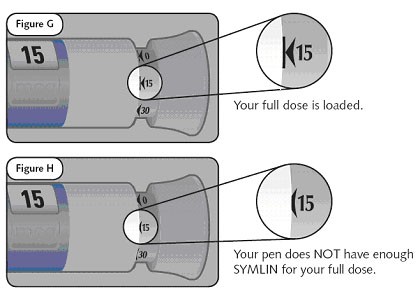

815002-FF



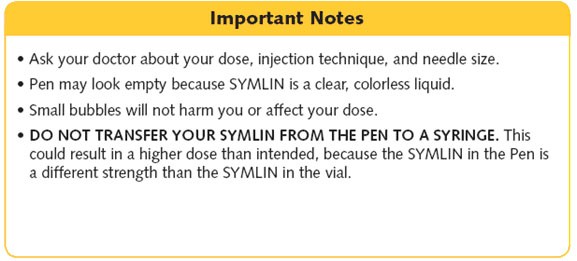
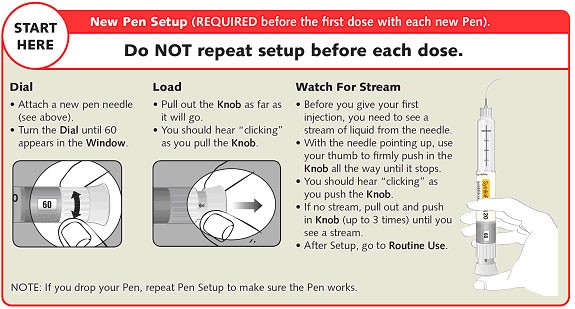

Literature Revised July 2008
SymlinPen® pen-injector (Pen)
Read these instructions carefully before using your Pen. Failure to follow these instructions may cause an incorrect dose, a broken Pen, or an infection.
- Check Pen label before each use to make sure you have the 60•120 mcg Pen.
- Check the expiration date (EXP) on the Pen label (see Pen Parts), and make sure the Pen is not expired.
- If you drop your Pen, go to New Pen Setup to confirm Pen works.
- If any part of your Pen appears broken or damaged, do not use.
- This Pen is not recommended for use by blind or visually impaired persons without the assistance of a person trained in the proper use of this Pen.
- If SYMLIN in the Cartridge (see Pen Parts) is not clear, colorless, and free of particles, do not use Pen.
Needles
- Use a new needle for each injection. Remove the needle from the Pen after completing each injection. This will help prevent leakage of SYMLIN, keep out air bubbles, reduce needle clogs, and reduce risk of infection.
- Pen needles are not included with the Pen. Use 29, 30, or 31 gauge disposable needles with the Pen. Ask your healthcare provider which needle gauge and length is best for you.
- Do not share your Pen or needles with anyone.
- Be sure the needle is completely attached to the Pen before use (see Attach Pen Needle). Do not push the Knob unless a needle is attached to Pen.
- Throw away used needles in a puncture-resistant container or as directed by your healthcare provider. Do not throw away the Pen with a needle attached.
- Follow local or institutional policies regarding needle handling and disposal.
Care and Storage
- Pen that has never been used:
- Refrigerate (36°F to 46°F, 2°C to 8°C).
- Protect from light.
- Do not freeze. Do not use a Pen that has been frozen.
- Pen in use:
- After the Pen is used for the first time (first use), refrigerate or keep at a temperature up to 86°F (30°C) for 30 days. Throw away Pen 30 days after first use, even if it still has SYMLIN in it.
- Pen should not be used after the expiration (EXP) date printed on the label.
- Do not store Pen with needle attached, or with Knob pulled out.
- If needed, wipe only the outside of Pen with a clean, damp cloth (water only).
- White particles may appear where the needle attaches during normal use. You may remove the particles with an alcohol wipe or alcohol swab.
- Keep Pen and needles out of the reach of children.
About SYMLIN
- The way you inject SYMLIN is similar to the way you inject insulin. Inject SYMLIN under the skin (subcutaneously) of your stomach area (abdomen) or upper leg (thigh). Inject SYMLIN at a site that is more than 2 inches away from your insulin injection. To help reduce the chances of getting a reaction at the injection site, allow SYMLIN to come to room temperature before injecting. Also, use a new needle for each SYMLIN injection.
- If you take more than your prescribed dose of SYMLIN, you may get nauseous or vomit, and you may not be able to eat the amount of food you usually eat. Pay careful attention to the amount of insulin you use at this time as you may be at more risk for low blood sugar. Contact your doctor for guidance.
- If you miss or forget a dose of SYMLIN, wait until the next meal and take your usual dose of SYMLIN at that meal. Do not take more than your usual dose of SYMLIN.
Questions and Answers (Q&A)
Why does my new Pen look empty?
- Because SYMLIN is clear and colorless, the Cartridge (see Pen Parts) may look empty, even though there is medicine in it.
- To be sure there is SYMLIN in the Cartridge, perform Pen setup (see New Pen Setup).
What should I do if I see air bubbles?
- The Cartridge may contain small air bubbles. Small air bubbles are normal and will not harm you or affect your dose.
- Perform New Pen Setup before the first dose with each new Pen (see New Pen Setup).
- To prevent more air bubbles, do NOT store Pen with needle attached.
Why can't I turn the Dial?
- If the Knob has been pulled out, the Dial will not move and you cannot reset your dose. Push in the Knob to discard the dose and repeat the instructions (see Routine Use).
- If the Knob is pushed in all the way, and you cannot rotate the Dial, call Amylin Customer Support.
What should I do if I do not see a stream of liquid when I perform the setup?
- Watch for a stream when you start to push the Knob.
- The liquid is clear and colorless, so it may be difficult to see.
- Pull out the Knob all the way - you will hear clicking.
- Firmly push in the Knob all the way - you will hear clicking.
- If there is no stream of liquid after 3 attempts, replace the needle and repeat setup.
- If still no stream, call Amylin Customer Support.
What should I do if I load an incorrect dose?
- Do not inject an incorrect dose. Point the needle away from you and discard the dose by pushing in the Knob all the way. Dial your correct dose.
How do I make sure I am getting my correct dose of SYMLIN?
- Before pulling out Knob, be sure the number in Window matches your prescribed SYMLIN dose (see Figure A).
- Pull out the Knob all the way - you will hear clicking (see Figure B).
- Be sure that number on the Dose Check matches your dose in Window. You must see line, arrow, and number
 on Dose Check (see Figure C).
on Dose Check (see Figure C). - Firmly push in the Knob all the way - you will hear clicking.
- Hold Knob for 10 seconds before removing needle from skin (see Figure E).
Why do I see SYMLIN leaking from my needle after I inject?
- You may see one or two drops - this is normal.
- If you see more than 2 drops:
- You may not have received your full dose.
- Do not inject another dose.
- Talk to your healthcare provider.
- To prevent dripping or leaking, be sure to firmly push and hold Knob with your thumb for 10 seconds before removing needle from skin.
How do I know when my pen is empty?
- Check Your Dose after pulling out the Knob (see Figure C).
- The lines on the Cartridge show approximately how much SYMLIN is left in the Pen. When the Plunger is at the thickest line on the Cartridge, your Pen is almost empty (see Figure F).

- If you cannot see the line, arrow, and number
 that match your prescribed dose, you do not have enough SYMLIN to give your full dose (see Figure H). Throw away this Pen, and use a new Pen to give your dose.
that match your prescribed dose, you do not have enough SYMLIN to give your full dose (see Figure H). Throw away this Pen, and use a new Pen to give your dose.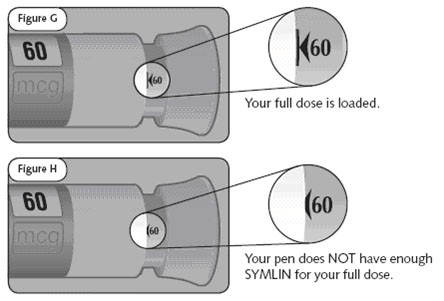

815003-FF
PRINCIPAL DISPLAY PANEL - 5 mL Vial Label
NDC 66780-110-01
Rx Only
Symlin®
(pramlintide acetate) injection
0.6 mg/mL
5 mL Vial
SUBCUTANEOUS USE ONLY
AMYLIN Pharmaceuticals, Inc.
San Diego, CA 92121 USA

PRINCIPAL DISPLAY PANEL - 5 mL Vial Carton
Subcutaneous Use Only
Rx Only
NDC 66780-110-01
Symlin®
(pramlintide acetate) injection
0.6 mg/mL
5 mL Vial
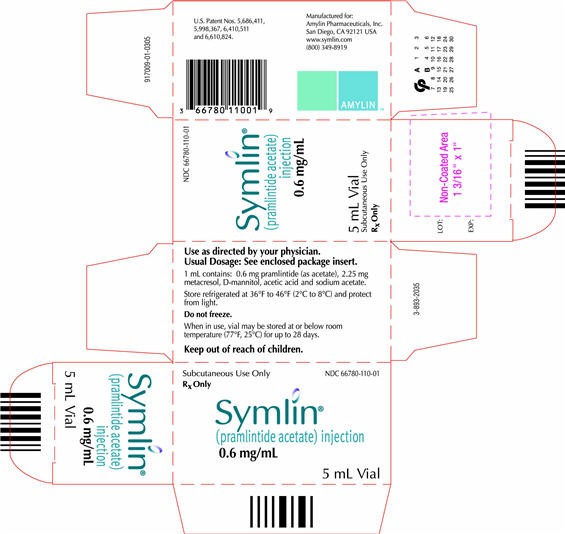
PRINCIPAL DISPLAY PANEL - 1.5 mL Cartridge Label
LOT/EXP
911002-02
NDC 66780-115-02
SymlinPen®
60
(pramlintide acetate)
pen-injector
For doses of 15 mcg, 30 mcg,
45 mcg, and 60 mcg.
1000 mcg/mL, 1.5 mL
Rx Only
Amylin Pharmaceuticals, Inc.
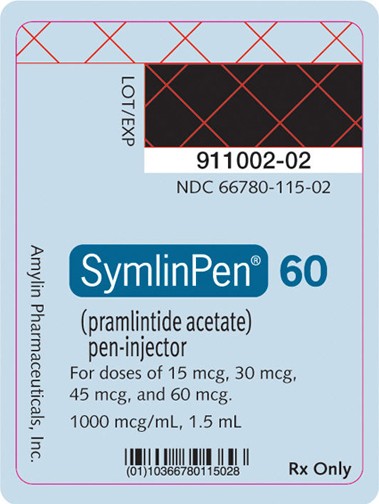
PRINCIPAL DISPLAY PANEL - 1.5 mL Cartridge Carton
SymlinPen®
60
(pramlintide acetate)
pen-injector
For doses of 15 mcg, 30 mcg,
45 mcg, and 60 mcg.
Two disposable multidose
pen-injectors pramlintide acetate
1000 mcg/mL, 1.5 mL
NDC 66780-115-02
Rx Only
Two 1.5 mL disposable multidose pen-injectors
15•30•45•60 mcg
Subcutaneous use only. Pen needles not included. Use 29, 30, or 31
gauge disposable pen needles. Ask your healthcare provider which
needle gauge and length is best for you.
AMYLIN®
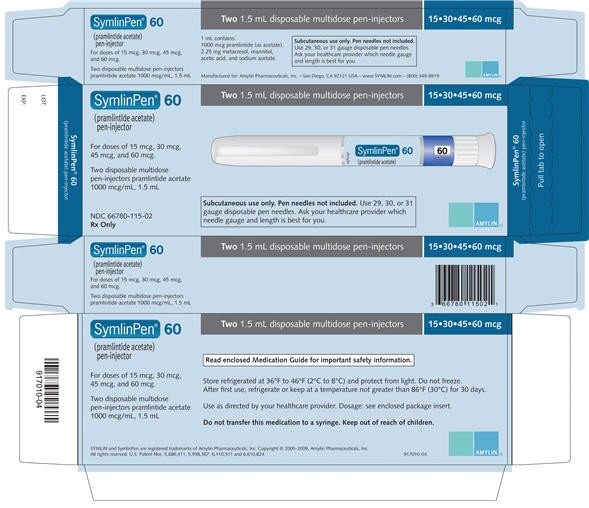
PRINCIPAL DISPLAY PANEL - 2.7 mL Cartridge Label
LOT/EXP
911004-03
NDC 66780-121-02
SymlinPen®
120
(pramlintide acetate)
pen-injector
For doses of 60 mcg and 120 mcg.
1000 mcg/mL, 2.7 mL
Rx Only
Amylin Pharmaceuticals, Inc.
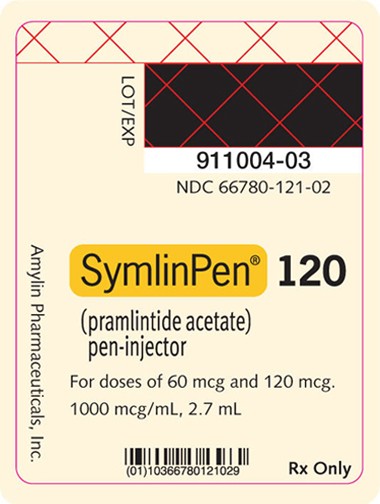
PRINCIPAL DISPLAY PANEL - 2.7 mL Cartridge Carton
SymlinPen®
120
(pramlintide acetate)
pen-injector
For doses of 60 mcg and 120 mcg.
Two disposable multidose
pen-injectors pramlintide acetate
1000 mcg/mL, 2.7 mL
NDC 66780-121-02
Rx Only
Two 2.7 mL disposable multidose pen-injectors
60•120 mcg
Subcutaneous use only. Pen needles not included. Use 29, 30, or 31
gauge disposable pen needles. Ask your healthcare provider which
needle gauge and length is best for you.
AMYLIN®
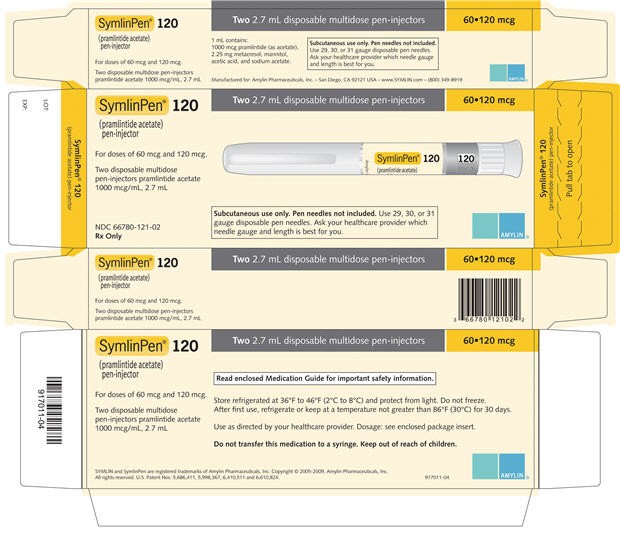
SYMLINpramlintide acetate INJECTION
| |||||||||||||||||||||||||||||||||||||||||||||||||||||||||||||||||||||
SymlinPenpramlintide acetate INJECTION
| ||||||||||||||||||||||||||||||||||||||||||||||||||||||||||||||||||||||||||
SymlinPenpramlintide acetate INJECTION
| ||||||||||||||||||||||||||||||||||||||||||||||||||||||||||||||||||||||||||